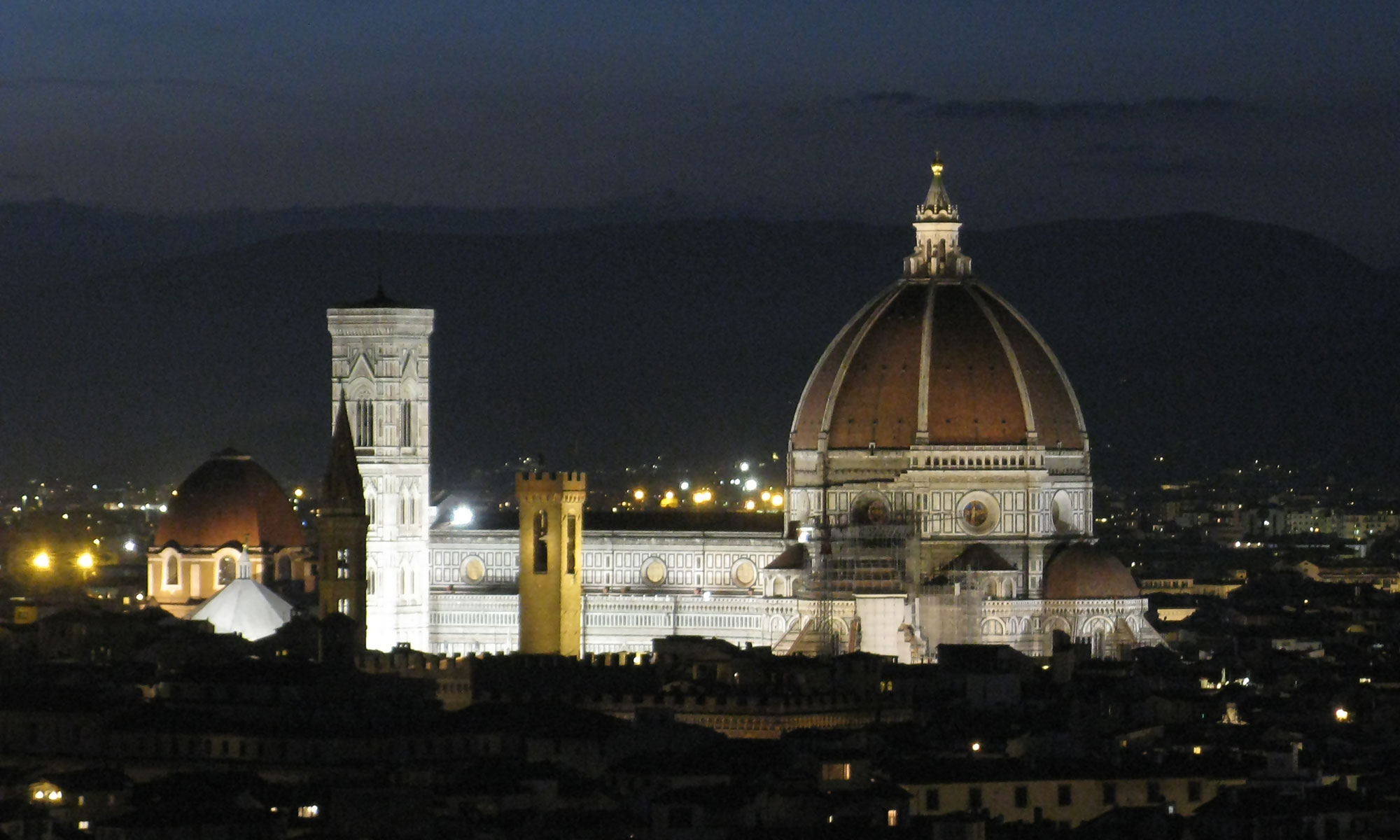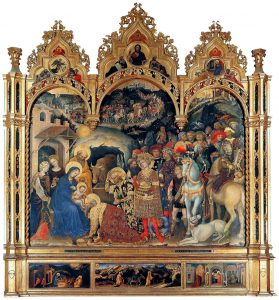Guest Blog by Frank Weaver
The long, dark, cold nights of December are immeasurably warmed and brightened by the Christmas decorations that mark the holiday season: colored lights, tree ornaments, elaborate wreaths—and not least of all, the indoor and outdoor Nativity scenes that homeowners, churches, and municipalities display to remind us of the meaning of that season. But what inspired this tradition?
On a recent trip to Italy I wanted, of course, to immerse myself in the natural, cultural, artistic, and day-to-day charms of that country, especially in the vicinity of Florence. But I also made a particular point of seeking out the origins of the Nativity Scene tradition within the unrivaled collections of art found throughout that country.
The Nativity in Florence and Milan
I did not have to search hard.
Upon stepping off the plane in Milan, I headed straight for that city’s beautiful cathedral, the “Duomo.” And practically the first thing I spotted was a Nativity scene (carved in 1902 by Italian sculptor Ludovico Pogliaghi) on one of the panels of the immense bronze doors of the cathedral. And then I was off to Florence where, lo and behold, a similar scene had been carved in the 1400s by Lorenzo Ghiberti in one of the gilded door panels of the Baptistry in the Piazza del Duomo.
The Nativity in Fiesole
A previous blog on this site explored the historic origins of outdoor Nativity scenes. As it turns out, the true beginnings of what we might recognize as a modern Christmas celebration can be traced back to the year 1223. It was then that St. Francis of Assisi, inspired by a recent trip to the Holy Land, staged a celebratory “Nativity Scene” in Greccio, Italy. St. Bonaventure describes it thus in his Life of Saint Francis, Chapter X:
Now three years before his death it befell that he was minded, at the town of Greccio, to celebrate the memory of the Birth of the Child Jesus, with all the added solemnity that he might, for the kindling of devotion. That this might not seem an innovation, he sought and obtained license from the Supreme Pontiff, and then made ready a manger, and bade hay, together with an ox and an ass, be brought unto the spot. The Brethren were called together, the folk assembled, the wood echoed with their voices, and that august night was made radiant and solemn with many bright lights, and with tuneful and sonorous praises.
Florence was crawling with tourists, even in mid-September; so my first day there, I took the public bus up a winding road to the small hilltop town of Fiesole, far from the madding crowd, where I discovered a hidden treasure: the Franciscan Monastery and Museum. And there I found the ultimate Christmas display: a ¼-life-size 3D diorama of that first Nativity Scene, as described by Bonaventure. (Please excuse the blurry quality of these photos: the poor lighting and plexiglass screen in front of the diorama conspired against an ideal photographic composition.)
Also on display in the museum—and matching the stark simplicity of the Franciscan diorama—was a small sculpture by Margot Einstein (daughter of the great physicist) that reduces the details of the event to their two most basic and essential elements: Mary and her newborn infant:
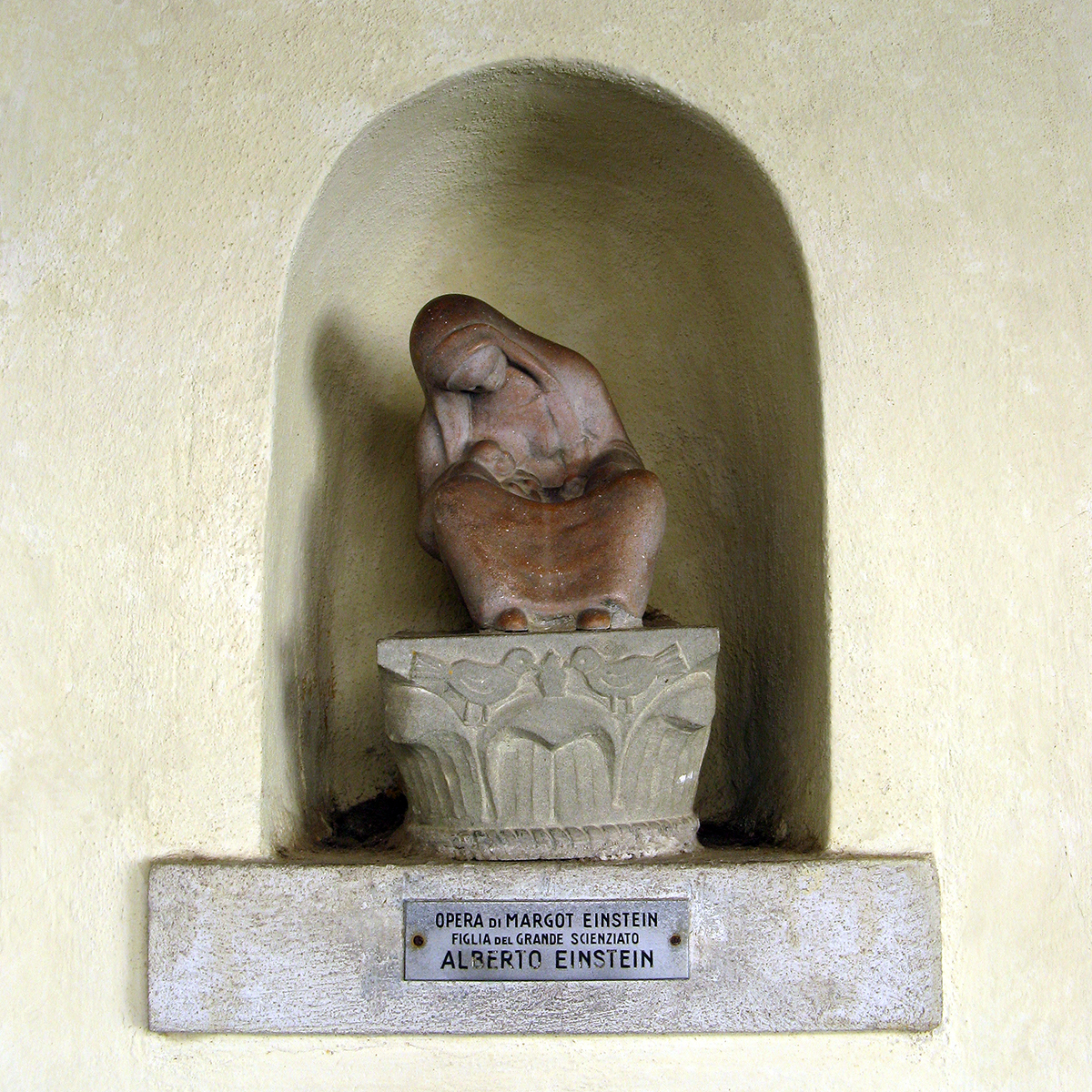
The Nativity in the Uffizi Gallery
Once back in Florence, I hit paydirt at this world-renowned museum. Previously almost completely overlooked as a subject by artists before St. Francis got the ball rolling, the First Nativity (as described in scant detail in the New Testament) became one of the most popular themes for artists, from the Gothic period, through the Renaissance, and up to the present day. It is a subject upon which they often unleashed their greatest skill, bounded only by their considerable powers of imagination.
Among the greatest of those countless artists to depict this event was none other than Leonardo da Vinci. In this early work, begun in 1481 but left unfinished, the Virgin Mary and Child are depicted in the foreground and form a triangular shape, with the Magi kneeling in adoration. Behind them is a semicircle of accompanying figures (including what may be a self-portrait of the young Leonardo on the far right). In the background on the left is the ruin of a pagan building, on which workmen can be seen, apparently repairing it. On the right are men on horseback fighting, along with a sketch of a rocky landscape.
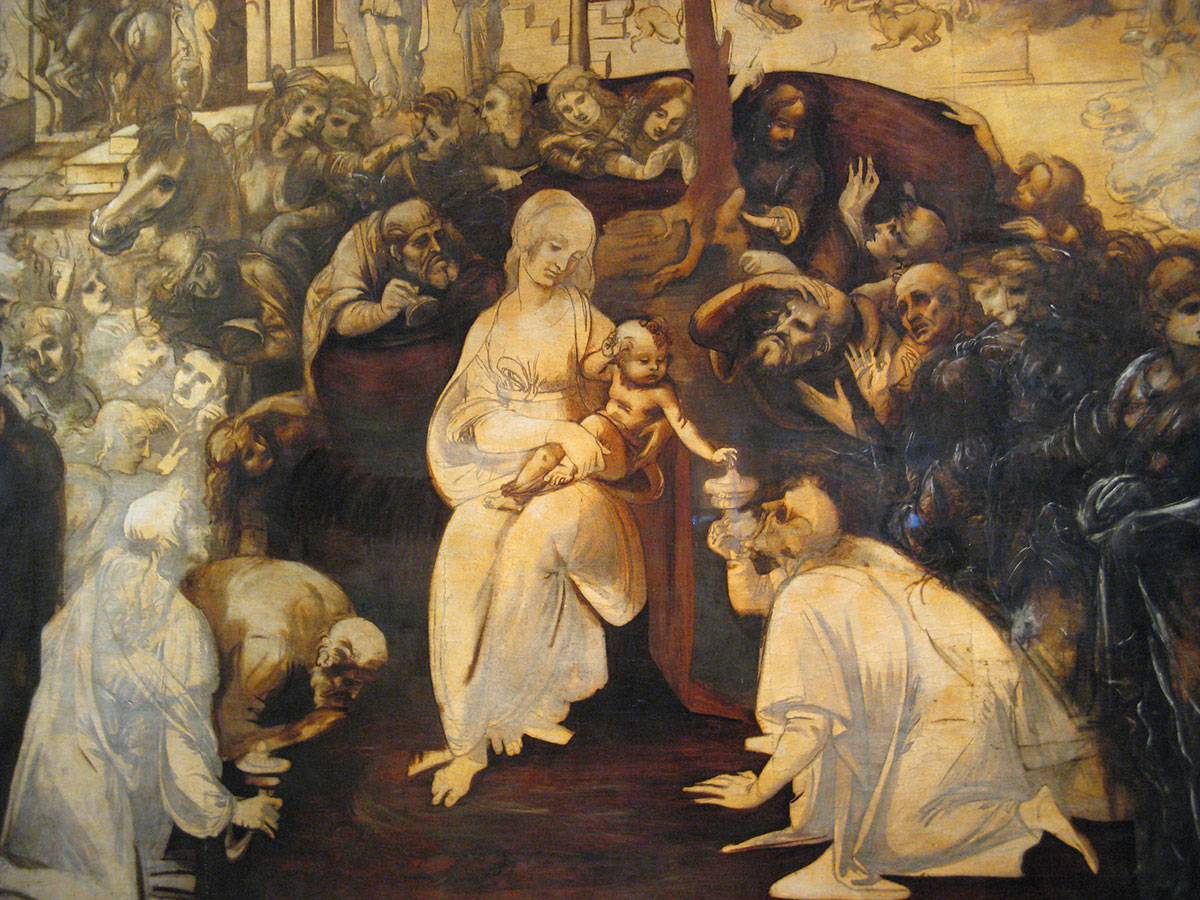
Compare Leonardo’s work to a similar setting depicted by Filippino Lippi (1496), in particular as it regards the central part of the painting. Much of its inspiration was clearly derived from Botticelli’s own Adoration of the Magi (also in the Uffizi—see further below), as is evident in the disposition of the characters on the two sides, with the Holy Family portrayed in the centre.
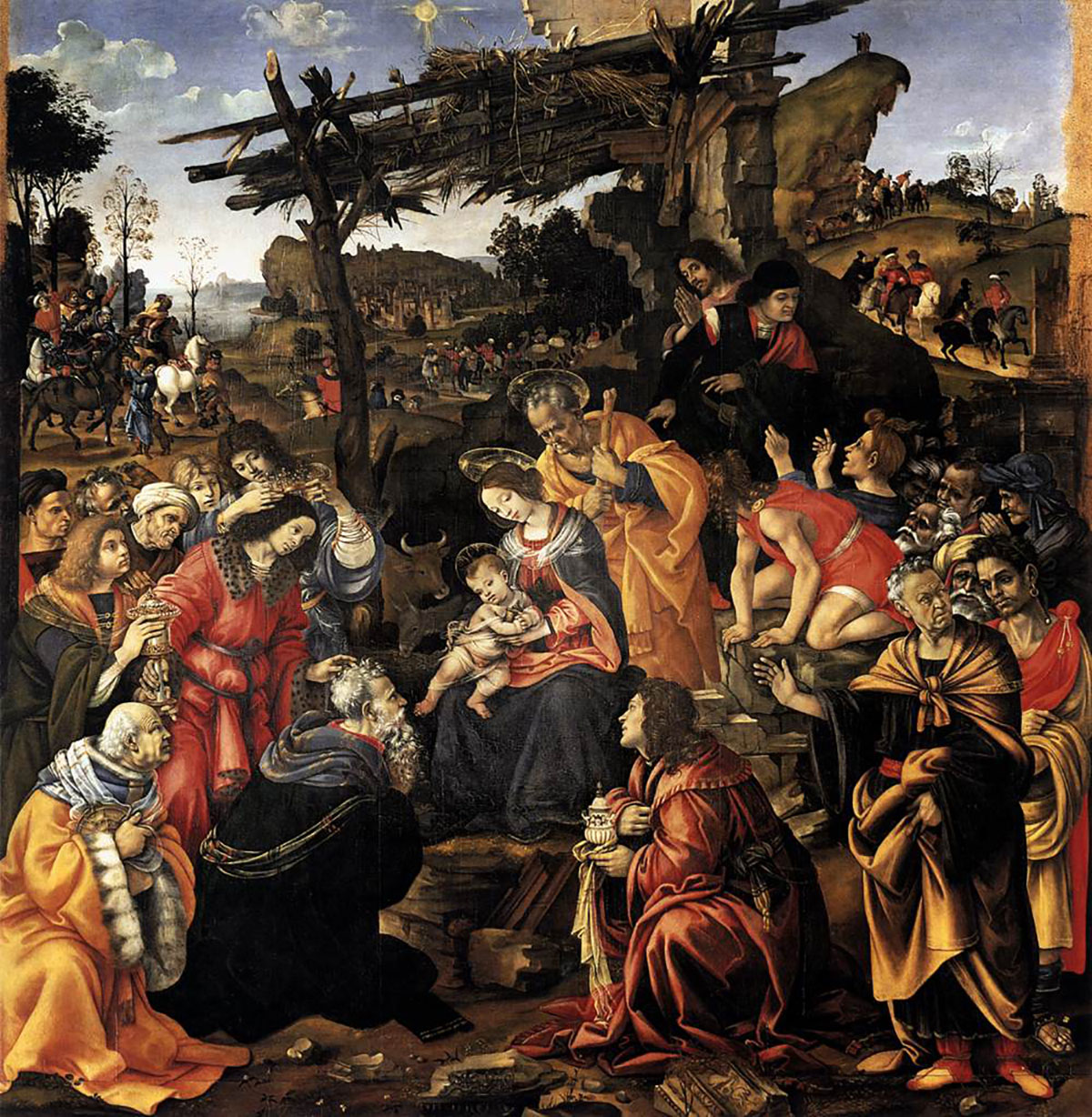
The true genius of Renaissance painting is clearly apparent in Sandro Botticelli’s version of the Adoration of the Magi (1475), which Giorgio Vasari described in his Lives of the Most Excellent Painters, Sculptors, and Architects as “a marvelous work in color, design and composition.” It was also a highly innovative work. The “Adoration of the Magi” was already a popular theme among Italian painters; but it was Botticelli who introduced the concept of a truly frontal view of the represented scene. At the center there are the holy figures, which here are in a higher position than the others. On either side there are the other characters, arranged symmetrically.

Of all such scenes like this in the Uffizi (and there were many!), I would say my favorite was Domenico Ghirlandaio’s (1487). Here the homage of the Magi to the newborn Savior is set against a backdrop dominated by the ruins of an ancient building, with the stable where Jesus was born in the middle. This is a recurring setting in paintings of the Nativity and the Adoration of the Christ Child, and one that alludes to the birth of Christianity and the collapse of pagan religion. The decorative friezes on the portico are inspired by ancient Roman art, which Ghirlandaio was able to admire on his travels to Rome (where, among other things, he worked on the decorations of the Sistine Chapel in St. Peter’s Basilica). The Virgin and Child are the focus of the composition; the Wise Men are kneeling before them, recognizable by the crowns that they have placed at the feet of the Saviour. A servant, whose dark skin emphasizes that the kings and their large following have come from the East, is removing the diadem from the head of the youngest of Magi—presumably to hand it to the newborn Prince of Peace.

Like the above, certain pieces in the Uffizi were notable not just for the paintings themselves but for the artistry of the frames that contain them and which, indeed, form an integral part of each work. Take, for example, Lorenzo Monaco‘s Adoration of the Magi (1420–1422), where the lower part is taken up by the composition itself, while the upper part is in the form of a frame creating a triptych. On the left is portrayed the Nativity scene, while the centre and right sides are occupied by the Magi’s procession. Differently from the Gospel tradition, they are not all portrayed as old men, but with three different ages symbolizing the all three ages of man. Their followers include a variety of ethnicities, from the Moors to the Tatars, as well as animals such as hounds and camels.
In like manner, the frame of Gentile da Fabriano’s Adoration of the Magi (1423)—considered by many to be the artist’s finest work—is also a work of art in itself, characterized by three cusps at the top with tondoes portraying Christ Blessing (center); the Annunciation with the Archangel Gabriel on the left; and the Madonna on the right. The main panel portrays the path of the three Magi, in several scenes that start from the upper-left corner (the voyage and the entrance into Bethlehem) and continue clockwise, to the larger meeting with the Virgin Mary and the newborn Jesus, which occupies the lowest part of the picture. All the figures wear splendid Renaissance costumes, including brocades richly decorated with real gold and precious stones inserted in the panel. Gentile’s typical attention to detail is also evident in the exotic animals in attendance, such as a leopard, a camel, some apes, and a lion, as well as several magnificent horses and a hound.
This obsession with detail in both foreground and background—so typical of Renaissance artists—is clearly seen in Cosimo Rosselli’s Adoration of the Magi (ca. 1470).

Gorged finally on all this Renaissance attention to detail, then, I was relieved at last to rest my eyes on the much simpler—and less crowded—Madonna and Child with Saints by Alesso Baldovinetti (ca. 1454), whose work exemplifies the careful modeling of form and the accurate depiction of light characteristic of the most progressive style of Florentine painting during the last half of the 15th century
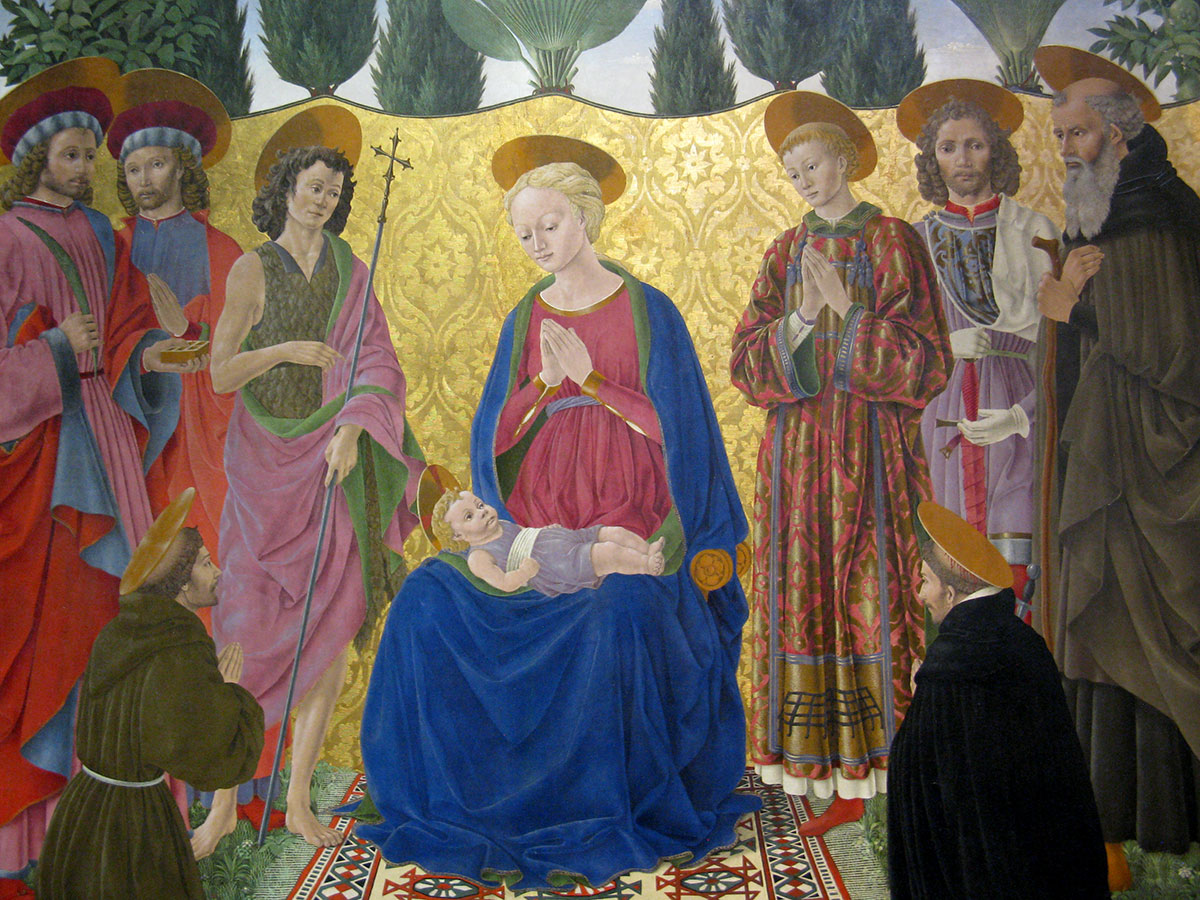
What with all those richly dressed saints, angels, and Magi depicted in the aforementioned paintings, one must finally begin to wonder: what about the lowly shepherds?! They seem to have gotten short shrift in the Renaissance period. But not entirely! Upon the Portinari Altarpiece in the Uffizi Gallery I stumbled upon at last this work by Flemish painter Hugo van der Goes: The Adoration of the Shepherds (1475). In the central panel, three shepherds fall to their knees before the child Jesus—with no splendid Magi in sight. Moreover, Van der Goes painted these rustic characters very realistically. Kneeling angels surround the Virgin and the Child, who is not even in a crib but lies instead on the bare ground surrounded by an aureole of golden rays.

Which brings us back what should be the main focus of all such Nativity Scenes: the beauty, hope, and utter simplicity inherent in the birth of the Savior. This ideal is epitomized perfectly in Gerard van Honthorst’s Adoration of the Christ Child (1619–1621):

Painted during the Dutch Golden Age period, the Adoration of the Christ Child shows a moonlit scene with Mary laying the Child in swaddling clothes. Joseph is looking over her shoulder while two angels lean over the crib.
And here is what makes this painting so especially apropos as a depiction of the Nativity: the moonlight is reflected off the faces of the figures in such a way that suggests the Child Himself is the light source.
I hope these artworks inspire readers to celebrate the next Christmas season by displaying detailed (or simple) Nativity Scenes that are equally artistic!


